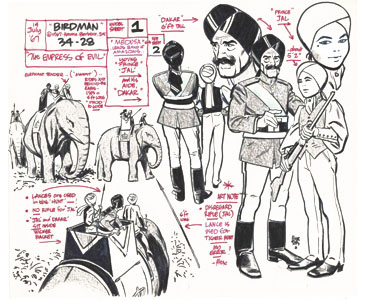
A number of fans of Alex Toth's comic book art seem to be a little puzzled about his vast body of work in the animation field. Most of it was done for Hanna-Barbera Studios, which was not far from his home and where his wife Guyla worked as a secretary to Joe Barbera. (And I hasten to add that that job description does not do her justice. She was a lovely and extraordinary woman who did a lot to keep that chaotic studio running.)
Alex had several functions for Hanna-Barbera. One was in the designing and selling of shows. H-B was basically in the business of getting networks to buy new programs and, once sold, the production of a given show was almost an afterthought. Alex was brought into meetings with writers and network execs where his skill for rapid drawing was given a workout. He'd sketch what they pitched and shape the melange of ideas into something visual, tossing in ideas of his own. Some people aren't sure if he created shows like Space Ghost, Herculoids, Mightor, Birdman, etc., and the answer is that he usually created the visuals and occasionally contributed ideas to the concepts. So I don't know that the word "created" really applies.
Then Alex would prepare large boards of color artwork — sometimes colored by him, often colored or otherwise embellished by others in the studio — that would be used as further selling tools in meetings. A cartoon show must often be pitched, re-pitched and re-re-pitched, meaning that Joe Barbera (or someone) would pitch it to network guys and then the network guys would pitch it to higher-ranked network guys and somewhere along the way, someone might have to re-re-pitch it to ad agencies. Having good art boards as visual aids can be an enormous aid for any pitcher, and Toth's were among the best.
After a show was sold and they began making episodes, Alex would usually do model sheets to design the characters — both the regulars and the "incidentals." Incidentals are new characters that appear in only one episode…and there would also be model sheets for vehicles, major props, key pieces of scenery, etc. He produced hundreds of these, perhaps thousands, and they are avidly collected by appreciators of fine comic-style illustration. They were a bit more controversial within the studio where some felt that Toth was the wrong guy to have setting the parameters of what everyone else would then have to draw. Everyone admired his drawing ability but there were those who argued that he was either too good or too special.
In most cases, the artists who would have to then draw the characters based on Alex's models had nowhere near his skills, or at least nowhere near the skills for that kind of illustration. H-B did adventure shows but they also continued to produce shows in what one might call the Yogi Bear style. Depending on what kinds of shows were sold each year and how many, it sometimes happened that a "Yogi Bear" artist would get assigned to an adventure show and many of these otherwise skilled artists struggled to replicate the kind of thing Toth was doing on the model sheets. Even a few artists who were solid in adventure-style art found his work too angular at times. Some Toth model sheets were worked over by others — traced and simplified (some would say, "watered-down") — before they went into production. But many artists were also stimulated by the challenge they presented and found that the designs were solid and, as is necessary with animation, designed with an absolute economy of line.
As I mentioned, animators still hoard and trade copies of them. It is not uncommon that an artist assigned to do up a model sheet of a policeman for some new show will haul out a Toth model sheet of a policeman and trace it, making just enough changes to pass it off as new…or not. I have seen Toth-designed characters appear without modification in shows he had nothing to do with, and I expect we always will. It's just part of the grand legacy that the man leaves us.